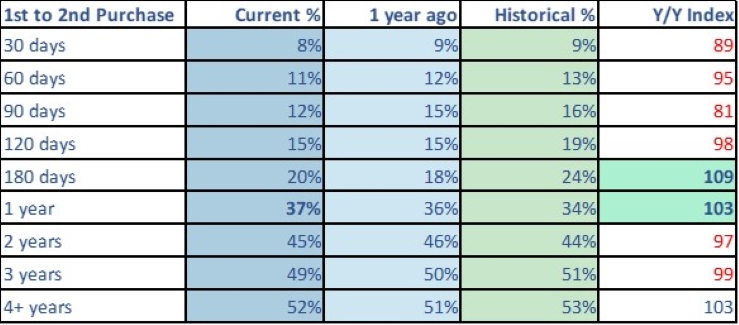Why you Should be Tracking Time Between Purchases—And How to Use It to Drive Growth
- By Elisa Berger
Some KPIs take time to change—like lifetime value or customer lifecycle migration. While others, like time between purchases, are early warning signs that something’s brewing beneath the surface. The latter is a leading indicator yet often overlooked because it can be tricky to measure without a robust marketing database. But without this insight, you’re flying blind. Here’s why this metric matters—and how you can use it to drive smarter, faster growth.
What Is Time Between Purchases—and Why Does It Matter?
Time between purchases measures how many days typically pass between a customer’s orders. It’s more than just a number—it’s a window into customer behavior. It tells you how engaged your customers are, how often they’re thinking about your brand, and how effectively you’re staying top of mind.
At Cross Country Computer, I like to measure this in 30-day cumulative intervals, segmented by lifecycle stage—specifically the 2nd, 3rd, or 4th purchase and even by product or segment (i.e. Consumer vs. B2B, Pro vs. DTC, etc.). For example, I track what percentage of first-time buyers go on to make a second purchase in 30, 60, 90 days, continuing through two years, and then years three and four. I compare this month-over-month and year-over-year to spot trends and shifts.
What I’m looking for:
- Is the rate of repeat purchase improving, stable, or slowing?
- How many first-time buyers convert to two-time buyers within the first year?
- Has your 30-day conversion rate dropped suddenly? That’s a signal to act quickly before downstream conversion is impacted.
- At what point do 70% of eventual repeat buyers actually convert? That timing can guide when you should start treating customers as if they are “at risk”.
These insights directly inform customer journey design, retention campaigns, and reactivation strategies—ultimately accelerating revenue growth.
What Purchase Timing Can Tell You
- Customer Engagement Health
If the interval between purchases is stretching, it’s a red flag. It may mean the customer wasn’t satisfied, is exploring competitors, or simply hasn’t found a reason to return. In this example below, you can see a slowdown in purchases happening in the first 4 months. Activity in the 6 months to 1 year milestone following the first purchase is better but it won’t stay this way if the trends of the most recently acquired new buyers remain the same. You can also see that 70% of all customers who will ever make a 2nd purchase will do so in the first year. Thus, also increasing the pressure on early intervention.

- Better Forecasting and Inventory Planning
Consistent tracking improves demand forecasting, helps reduce stockouts, and supports more efficient operations. In the table above, you can see that 37% of all first-time buyers make their 2nd purchase within the first year. That means that 63% do not come back in the next 12 months. Given that, you must rely on additional acquisition and existing buyer retention strategies to fill the gaps.
- Product Lifecycle Insights
Time-based patterns reveal natural usage or replenishment cycles—especially for consumables like skincare or supplements. Knowing when a customer will run out lets you time your next touchpoint with precision. For longer-cycle products, early and relevant product recommendations can keep your brand top of mind.
- Smarter Segmentation
Purchase cadence is a powerful segmentation signal. Those with shorter intervals between purchase might be ready for loyalty programs, while buyers who are slowing down can be nudged with win-back tactics. You can even use this metric right after the first purchase to predict behavior given the product category purchased and personalize journeys accordingly.
How to Reduce the Time Between Purchases
Measuring is step one—but reacting to the signals is how you stay ahead. It’s much easier to prevent churn than to win back disengaged customers. Here are some tactics that we’ve seen drive results across product offers:
1. Triggered Replenishment Reminders
Know the average reorder interval? Use it. Create a series of triggered reminders that go out before the customer is likely to run out. A gentle nudge—possibly paired with a small incentive—can prompt the next purchase before they run out.
2. Introduce Personalized Cross-Sells Early
Our cross-shopping studies show that most customers tend to repurchase within the same product category. Use that insight to recommend top sellers in that same category soon after the initial sale. Next, you can layer in adjacent or complementary products. For instance, if someone buys a top, offer top selling tops but also suggest popular pants, skirts, or shorts. Create logical, helpful buying paths that guide the customer to their next purchase.
3. Build Engagement Beyond Asking for the Sale
Not every communication needs to push a sale. Relationship building is also key. Mix in educational content that allows buyers to get to know your brand, how-to guides, loyalty point updates, or referral incentives. Keep the brand experience alive.
The time it takes a customer to buy again is one of the clearest indicators of how your business is performing—and where it’s headed. If you’re not tracking purchase intervals, you’re missing the chance for early intervention and are taking a re-active approach to marketing. If you are tracking but not acting, you’re only halfway there. But if you’re using this data to align your marketing communications — you’re doing exactly what smart, data-driven brands do to grow faster and stronger – even in tough economic conditions.

Elisa Berger, Ph.D., is Principal and President at Cross Country Computer (CCC). A recognized expert in data-driven marketing, Elisa has spent her career helping brands unlock greater ROI through smarter database strategies. She earned her Ph.D. in Applied Research from Hofstra University.
